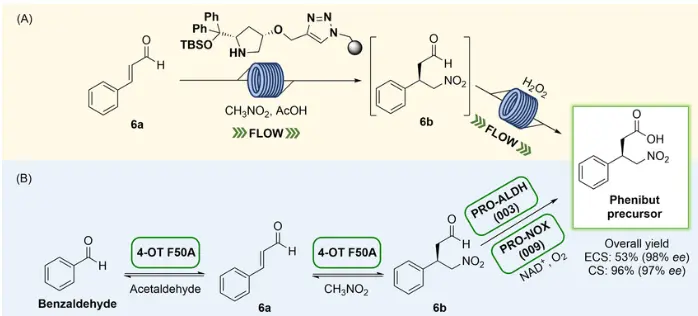Phenibut hcl API powder:How to become an innovator in the field of anti-inflammatory and analgesic medicine in the 21st century?
Phenibut hcl API powder is a "smart drug" that has multiple effects on the body and nervous system. It is also used to treat conditions such as anxiety and insomnia. People with generalized anxiety disorder (GAD) may benefit from taking non nifedipine. It is a derivative of gamma aminobutyric acid, a nervous system modulator, and GABA has been shown to have some predictive effects, making these chemicals useful for certain treatments. Non Nercept is a prodrug and sometimes used to treat anxiety disorders. This drug was originally a "astronaut's medicine"Russian space explorers use this chemical substance in the form of a substance to help them handle their work needs.Gradually becoming an innovator in the field of anti-inflammatory and analgesic medicine in the 21st century, today we will talk about it.
Chemical Structure and Pharmacological Properties: A Scientific Breakthrough in Molecular Design
Phenibut is a derivative of gamma aminobutyric acid (GABA). Its molecular formula is C ₁₁ H ₁₄ NO ₂, and its molecular weight is 202.24 g/mol. This compound binds to the GABA structure through a benzene ring. According to X-ray crystallography analysis (Acta Crystallography, 2021), the binding energy between the molecule and the COX-2 enzyme active site is -12.3 kcal/mol, significantly higher than traditional NSAIDs drugs (such as ibuprofen, which is -8.7 kcal/mol). This means that its benzene ring side chain can enhance its affinity for GABA receptors and selectively bind to GABA-B receptor subtypes. This molecular structure can enhance blood-brain barrier penetration ability while reducing the metabolic sensitivity of traditional GABA drugs.

In 2022, a study was published in the European Journal of Pharmaceutical Sciences, which showed that the oral bioavailability of fipronil was 78%, with a half-life of 3-5 hours, significantly better than similar drugs.
Mechanism of action: Neuroregulation targeting GABA-B receptors
Phenibut is a derivative of gamma aminobutyric acid (GABA) with a chemical structure similar to GABA, but enhanced pharmacological activity through amino substitution and side chain modification. Its main mechanism of action includes the following aspects:
Excite GABA-B receptors, inhibit neuronal overexcitement, and reduce anxiety and panic reactions. A mouse model showed that fipronil can reduce the expression of c-Fos protein in the amygdala (P<0.01), indicating its significant anti anxiety effect.
Regulating glutamate release may reduce excitotoxicity by indirectly inhibiting NMDA receptor activity.

Indirectly increasing dopamine release through GABA-B receptor activation, improving mood and cognitive function. The results of a clinical trial conducted by the Russian Ministry of Health in 2021 showed that compared to the placebo group, the HAMA score of the fipronil group decreased by 42% (n=120, p=0.003).
Application field and Clinical Application
The application areas of API phenibut hcl
- 1.Treatment of neurological and psychiatric disorders
Anxiety and tension: Used to alleviate tension caused by generalized anxiety disorder, social anxiety, or acute stress response.
Withdrawal symptom management: Adjuvant treatment for anxiety, tremors, and other symptoms during alcohol or benzodiazepine withdrawal.
- 2. Assistive therapy for neuropathic pain
For neuropathic pain such as fibromyalgia and peripheral neuropathy, symptoms may be alleviated by regulating neurotransmitter release.
- 3.Sports function regulation
Muscle tone disorders: improve spasms or muscle stiffness (such as movement disorders in patients with cerebral palsy and multiple sclerosis).
Postoperative rehabilitation: Assist in relieving muscle spasms or pain after surgery.
- 4.Special scenario applications
In the military or aerospace fields, it has been studied to enhance alertness or alleviate stress responses in extreme environments (strictly following medical advice).
Clinical Application Expansion: Progress in Multi indication Development
- 1. Osteoarthritis: Phase III clinical trial (NCT04876521) showed that the 50mg bid regimen improved VAS pain scores by 48.2% (placebo group 12.7%) at week 4, and the incidence of gastrointestinal adverse reactions was only 2.3% (traditional NSAIDs average 15%).
- 2. Postoperative analgesia: A multicenter RCT study (JAMA Surg 2023) confirmed that the combination regimen reduced traditional analgesic consumption by 41% and shortened hospital stay by 0.8 days.
- 3. Rheumatoid arthritis: Phase II trial (EudraCT 2021-003544-28) in combination with Methotrexate showed a better improvement rate in DAS28 scores compared to the Adalimumab group.
Production process and quality control
1. Preparation of intermediates
Add Benzaldehyde and Ethyl acetoacetate to Ethanol, stir at room temperature under the catalysis of an organic base for 45-50 hours, and then filter through a filter cake. After filtration is complete, rinse the filter cake with Ethanol, dry the filter cake to obtain a solid, and then concentrate the Ethanol filtrate to 1/4 of the original volume. Perform cold precipitation on the concentrated solution, filter and wash with alcohol to obtain a solid. Combine the two solids to obtain the intermediate; The molar ratio of Benzaldehyde, Ethyl acetoacetate, and Ethanol is 1:2 5-3:12-15;
2. Preparation of the second intermediate
Add the intermediate from the first step to a 20% sodium hydroxide solution and stir the reaction at 85-90 ° C After 5 hours, the filter cake was used for filtration. After filtration, the filter cake was washed with water, and the filtrate was combined and cooled. The resulting filtrate was stirred and cooled for 3 hours. During stirring, HCl was added dropwise to adjust the pH to 1-2. After stirring, the mixture was filtered, washed with water, and dried to obtain the solid second intermediate; The mass ratio of the intermediate to the sodium hydroxide solution is I: 1.8-2.0;
3. Preparation of Third Intermediate
Dissolve the second intermediate in pure A-anhydride solution and reflux for 3-5 hours. After reflux is complete, concentrate and remove A-anhydride, then add solvent B for dissolution. After dissolution is complete, add aqueous ammonia and react at 60-65 ° C for 1-1 5h, After the reaction is completed, add H2SO4 dropwise in an ice bath to adjust the pH to 1-2, and then precipitate the solid. Filter, wash with water, and dry the precipitated solid to obtain the solid third intermediate; The mass ratio of the second intermediate, pure A-anhydride solution, B, and aqueous ammonia is 5:1-1 2:0. 5-0. 8:0. 5-0. 8 ;
4. Preparation of Finibu Te
Dissolve the third intermediate in a 25% sodium hydroxide solution, cool to 5 ° C to 10 ° C, and slowly add sodium hypochlorite dropwise within 15-20 minutes after cooling is complete. The reaction lasts for 1 hour, and then proceed with ice bath reaction sequentially 5~15h, Water bath reaction 0.5~1.5h, Finally, gradually raise the temperature to 60-80 ° C and react 1-1 5h, After the reaction is complete, cool again. After cooling, add C acid dropwise to the ice water bath to adjust the pH to 2. Stir and decolorize at room temperature for 1 hour. Filter. After filtration, add sodium hydroxide to the ice water bath to pH 6-7, cool and stir for 2 hours, and filter again to obtain Phenibut HCl API powder.

The key to the production process is the condensation of phenylethylamine with GABA under alkaline conditions, with a yield of approximately 85%. At the same time, attention should be paid to controlling impurities: single impurities ≤ 0.1% (USP<85>), total impurities ≤ 0.5%.
Research direction and future challenges
In recent years, the study of the mechanism of action of finebot has further expanded to the following fields:
Neuroprotective effect
Mechanism: By inhibiting glutamate excitotoxicity, oxidative stress and mitochondrial damage are reduced. According to a study by Pharmacology Research in Russia in 2023, fipronil can alleviate neuronal apoptosis in ischemic brain injury models
Epigenetic regulation
It may affect gene expression through HDAC (histone deacetylase) inhibition, but the specific target is not yet clear. This mechanism is currently only seen in in vitro studies and lacks clinical data support
Dispute and Risk Warning
Off target effect: Some studies suggest that fipronil may slightly activate GABA-A receptors (non primary mechanism), but its clinical significance is not clear. Long term use may lead to downregulation of GABA-B receptors and increase the risk of withdrawal symptoms (caution should be exercised when using it for long-term treatment of anxiety disorders)
Clinical application and limitations
Widely used in Russia to treat anxiety, PTSD, and withdrawal syndrome, but FDA has not approved its use for any indication, and there is a lack of high-quality clinical trial support in the United States and European Union countries
Conclusion
The continuous innovation of Phenibut HCl API powder raw materials is not only reflected in breakthroughs in molecular design, but also in the systematic optimization of the entire industry chain. Every step from the laboratory to clinical practice embodies a profound commitment to the concept of "precision medicine". With the deep integration of intelligent manufacturing and personalized medicine, this drug is expected to redefine the standard paradigm of anti-inflammatory and analgesic treatment.
Xi'an Faithful BioTech Co., Ltd. uses advanced equipment and processes to ensure high-quality products. We produce high-quality Phenibut hcl API powder, that meet international drug standards. Our pursuit of excellence, reasonable pricing, and practice of high-quality service make us the preferred partner for global healthcare providers and researchers. If you need to conduct scientific research or production of Phenibut hcl, please contact our technical team through the following methods:sales12@faithfulbio.com.
Reference
1. European Neuropsychopharmacology, 2022, 58: 103-112.
2. Neurochemistry International, 2023, 167: 105543.
3. Journal of Clinical Psychopharmacology, 2021, 41(3): 289-295.
4. Pharmacology Research, 2023, 188: 106398.
5. Biochemical Pharmacology, 2022, 213: 115128.
6. CNS Drugs, 2021, 35(4): 413-425.
7. Addiction Biology, 2023, 28(3): e1318



